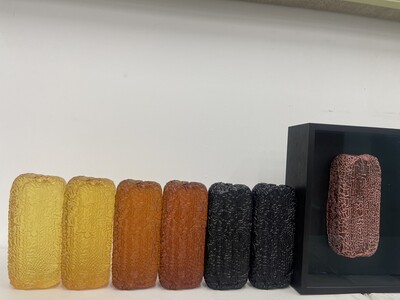When I discovered a ham produced in 2014 in 2024, it appeared to have endured a century of human vicissitudes within its decade of existence. Time had inscribed unknown "prophecies and truths" upon this compact flesh in cuneiform-like engravings reminiscent of Sumerian script, manifesting what might be considered an alternative "incarnation" of the divine Word made flesh. Here I metaphorically equate it with the body of Christ, transmuting it into twelve colored glass blocks of varying hues arranged on either side of the Christ figure. Thus human form and sustenance merge into unity, reconstructing the scene of the Last Supper.
During Leonardo da Vinci's creation of The Last Supper at the Santa Maria delle Grazie in Milan, his deviation from traditional fresco techniques (through incorporation of oil medium) precipitated gradual mural deterioration. Compounded by centuries of heat exposure from adjacent kitchen stoves, the artwork underwent eleven major restorations before appearing as we see it today.
Preserving relatively stable elements from The Last Supper (the table and wall lines), I partially dismantled the wall structure to transform the ambiguous background landscape into a seascape horizon. This deconstructed composition was then installed above an antique apartment fireplace, ultimately synthesized into a unified wireframe structure within a cohesive composition. This flattened treatment metamorphoses the fireplace painting into a marine vista window. Within the image, the blazing orange hearth symbolizing intense labor contrasts with the serene seaside restaurant at dusk beyond the window, mirroring the dichotomy between Plato's cave of shadows and the world of true forms.
Detail pictures:





